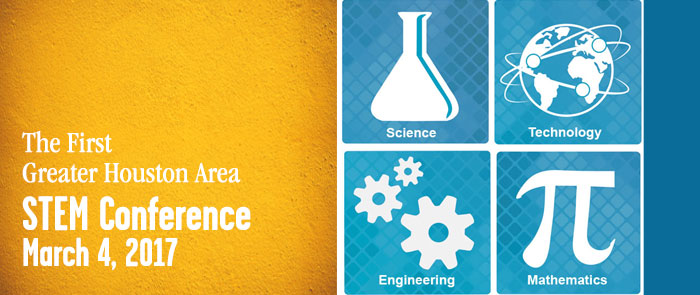
First Greater Houston STEM Conference boosts campus-wide STEM initiative
CORRECTION: 3/27/17 – Title for Gelyn Cornell was edited to say “K-6 Alief ISD Science Coordinator and K-12 Curriculum Coordinator.” Previously, Cornell’s title was written as “K-12 Alief ISD Science Coordinator.”
More than 300 educators and exhibitors from the Houston-Galveston and surrounding areas participated in the first Greater Houston Science, Technology, Engineering and Math (STEM) Conference titled “New Horizons and Innovations in STEM” held March 4 at the University of Houston-Clear Lake and co-hosted by the University of Texas Medical Branch (UTMB).
The conference was designed to address educators’ challenges of what STEM education should look like and how it can be integrated into the classroom.
“STEM education is the key to our future,” said Michelle Peters, associate professor in educational foundations, who coordinated the university-wide STEM initiative. “The challenge is that few truly understand what STEM should look like in the classroom. Educators have a good grasp of the key components – science, technology, engineering and mathematics – but struggle with the challenge of integrating. We are hopeful that this practitioner-based STEM conference will provide classroom teachers with ideas, tools, and resources to take back to their classrooms to assist them in this integration.”
Marguerite Sognier, UTMB director of Education Outreach and executive director of Southeast Regional T-STEM Center said STEM education conferences help educators to hone their skills and learn new things as education changes, science advances and new teaching tools emerge.
“STEM conferences like this help educators to refresh, renew, and become engaged,” Sognier said.
The conference featured presentations and STEM-related exhibits, as well as keynote speaker Steve Wolf, president of Wolf Stuntworks Inc., owner of Stunt Ranch, and the founder of Science in the Movies Inc., who presented, “Science in the Movies,” which teaches physics and chemistry through stunt demonstration.
Wolf explained that for teachers to effectively teach students, they have to teach outside of the system or in ways other than how they were instructed to teach because children’s attention levels have been reset by higher stimulus activities.
“[Children] are wired now for a higher level of engagement than the system is designed to provide,” Wolf said. “We need to step up the level of engagement in schools so that it achieves parody with the other stimuli that kids are exposed to.”
In order for America to compete in STEM fields worldwide, there has to be a transformation in the education system.
“It’s not kids that have changed,” Wolf said. “Biologically, nothing has changed genetically in the last 30 years; so if kids are failing now that used to be very successful than it’s the system that is educating them that is failing.”
Educators gathered in the UHCL Atrium II to view exhibits from companies like Tietronix, which showcased an immersive educational STEM and robotics game, “Code of Aegis,” that engages 6th-8th grade students and was developed in collaboration with UHCL.
“STEM education is a way to help today’s students understand how to think critically and problem solve, which will better prepare them for our future world,” said Monica Trevathan, director of education technology at Tietronix.” It’s wonderful to see so many teachers here who want to learn about STEM and how they can integrate science, technology, engineering and mathematics in their classroom.”
The conference drew in educators like Betty George, an Alief ISD K-6 science interventionist, who said she attended because she has “a heart for STEM and love[s] learning anything new about bettering STEM education.”
Conference attendee Gelyn R. Cornell, K-6 Alief ISD Science Coordinator and K-12 Curriculum Coordinator, explained that this type of conference helps her engage teachers in STEM education in order to mobilize the district and community toward STEM literacy.
With plans for a new STEM building underway, UHCL is aiming to become a STEM education destination.
“I think its our long term goal, within the college of education, to build a STEM pipeline that goes from the public schools: elementary, middle school, high school to the University of Houston-Clear Lake where students can pursue a STEM education,” said Mark Shermis, dean and professor of the College of Education.
Providing equal access to STEM education is at the core of the UHCL STEM initiative.
“It is important that we [UHCL] provide a pathway for groups that have not, in the past, been given the opportunity to receive a STEM education,” said Larry Rohde, department chair of Biological and Environmental Sciences and associate professor of Biology and Biotechnology.
Also published on Medium.
